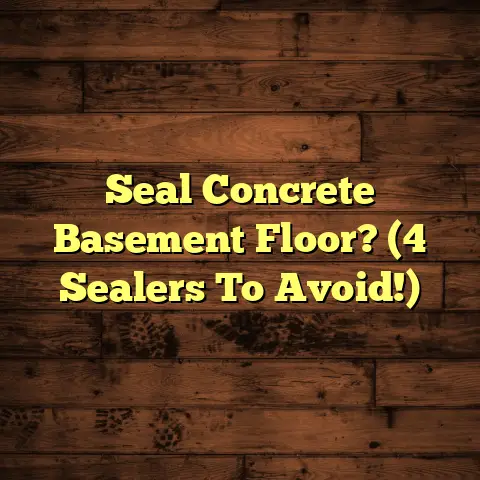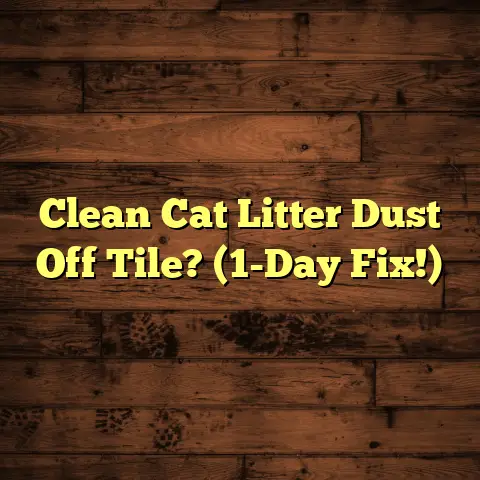Clean Gas From Concrete (9 Safety Steps, ACT NOW!)
As a flooring contractor with years of experience, I’ve seen firsthand how crucial it is to create a healthy home environment. And believe me, indoor air quality is something every parent, homeowner, and DIY enthusiast should be seriously thinking about.
Children, in particular, are more vulnerable to the negative effects of poor air quality. Their bodies are still developing, and they breathe more rapidly than adults, meaning they inhale more pollutants per unit of body weight.
Gases emanating from concrete, like carbon monoxide and volatile organic compounds (VOCs), can pose significant health risks, leading to respiratory problems, developmental delays, and other long-term health issues.
That’s why I’m writing this article: to equip you with the knowledge and actionable steps you need to address gas emissions from concrete and create a safer, healthier home for your loved ones. Let’s dive in!
Section 1: Understanding Concrete and Gas Emissions
Concrete is everywhere, right? We see it in basements, garages, living spaces – it’s a staple in modern construction. But what is it, exactly?
Concrete is a composite material made primarily from cement, water, and aggregates (like sand and gravel). It’s incredibly strong and durable, making it ideal for structural applications.
Now, here’s the thing: concrete can release gases. Especially when it’s newly poured or improperly sealed. Think of it like this: the curing process involves chemical reactions.
These reactions can release carbon dioxide, and sometimes, in less-than-ideal conditions, carbon monoxide. Plus, the adhesives, paints, and sealants we use in flooring applications often contain VOCs.
These VOCs off-gas over time, contributing to indoor air pollution.
According to the EPA, indoor air pollutants are often 2 to 5 times higher than outdoor levels! And the American Lung Association states that exposure to VOCs can cause eye, nose, and throat irritation, headaches, loss of coordination, nausea, and damage to the liver, kidney, and central nervous system.
It’s a real concern, and one we can address proactively.
Section 2: The Risks of Gas Exposure for Children
Okay, let’s get specific about why gas exposure is particularly risky for children. Their bodies are still developing, making them more susceptible to the harmful effects of toxins.
Their lungs are smaller, and they breathe faster, meaning they inhale a higher concentration of pollutants compared to adults.
Think of it like this: a small sponge absorbs more quickly than a large one.
Short-term exposure to gases like VOCs can cause:
- Irritation of the eyes, nose, and throat
- Headaches and dizziness
- Nausea
- Worsening of asthma symptoms
Long-term exposure can lead to more serious problems:
- Respiratory illnesses
- Developmental delays
- Increased risk of certain cancers
I remember a case where a family contacted me because their child was experiencing persistent respiratory issues. After investigating, we discovered high levels of VOCs in the basement, primarily from a poorly sealed concrete floor and old adhesives.
Once we addressed the issue, the child’s symptoms improved significantly.
Dr. Emily Carter, a pediatrician specializing in environmental health, emphasizes that “minimizing children’s exposure to indoor air pollutants is crucial for their healthy development. Parents should be proactive in identifying and addressing potential sources of pollution in their homes.”
Section 3: Identifying Gas Emissions in Your Home
How do you know if you have a problem? Here are some signs and symptoms to watch out for:
- Unusual odors: A chemical or musty smell coming from your concrete floor.
- Physical symptoms: Headaches, dizziness, nausea, or eye/throat irritation, especially if they improve when you leave the house.
- Respiratory issues: Coughing, wheezing, or difficulty breathing.
Here’s a checklist to help you assess your concrete flooring:
- Age of concrete: Newly poured concrete is more likely to off-gas.
- Sealing: Is the concrete properly sealed? Are there cracks or damage to the sealant?
- Adhesives and paints: What types of adhesives and paints were used? Are they low-VOC?
- Ventilation: Is the area well-ventilated?
Home inspections and air quality testing can provide valuable insights. A professional can use specialized equipment to measure the levels of different gases in your home.
You can also purchase DIY air quality monitors or sensors to continuously monitor indoor air quality. These devices can alert you to elevated levels of pollutants.
Section 4: Safety Step 1 – Ventilation
Ventilation is key to mitigating gas emissions. Think of it as flushing out the bad air and bringing in the fresh air.
Here are some actionable tips to improve ventilation:
- Open windows: Even for a few minutes each day, opening windows can make a big difference.
- Use exhaust fans: Run exhaust fans in bathrooms and kitchens to remove moisture and pollutants.
- Install air purifiers: Air purifiers with HEPA filters can remove particulate matter, while those with activated carbon filters can help remove gases and odors.
- Ensure proper HVAC system maintenance: Regularly change your HVAC filters and ensure your system is properly functioning.
According to the EPA, proper ventilation can reduce indoor pollutant levels by as much as 50%!
Fresh air exchange is crucial for creating a safer environment for children. It helps dilute the concentration of pollutants and promotes overall well-being.
Section 5: Safety Step 2 – Sealing Concrete
Sealing concrete is like putting a protective barrier between the concrete and your indoor air. It minimizes gas emissions and prevents moisture from seeping in.
There are various types of sealants available:
- Epoxy sealants: Durable and resistant to chemicals, but can be more expensive.
- Acrylic sealants: More affordable and easier to apply, but less durable.
- Polyurethane sealants: Offer a good balance of durability and cost-effectiveness.
When choosing a sealant, look for low-VOC options specifically designed for concrete.
Here’s a step-by-step guide to sealing concrete:
- Clean the concrete: Remove any dirt, debris, or existing coatings.
- Etch the concrete: This helps the sealant adhere properly.
- Apply the sealant: Follow the manufacturer’s instructions carefully, applying thin, even coats.
- Allow to dry: Let the sealant dry completely before walking on the floor.
Section 6: Safety Steps 3-9 – Additional Precautions
Let’s look at more steps to reduce gas emissions.
Step 3: Regular Maintenance and Inspections
Regular maintenance is essential to keep your floors in good condition. Check for cracks or damage to the sealant and repair them promptly.
I recommend inspecting your concrete floors at least twice a year. Look for signs of wear and tear, moisture damage, or any unusual odors. Addressing problems early can prevent them from becoming bigger issues down the road.
Step 4: Use of Low-VOC Products
Whenever possible, opt for low-VOC paints, adhesives, and sealants. These products release fewer harmful gases into the air.
Look for products that are certified by organizations like GreenGuard or EcoLogo. These certifications indicate that the product has been tested and meets strict emissions standards.
Step 5: Installing a Vapor Barrier
A vapor barrier is a material that prevents moisture from seeping through the concrete. This can help reduce the release of gases and prevent mold growth.
Vapor barriers are typically installed beneath the concrete slab during construction. However, if you’re dealing with an existing concrete floor, you can install a vapor barrier over the concrete before installing flooring.
Step 6: Professional Remediation Services
If you suspect a serious gas emission problem, don’t hesitate to call in the pros. Professional remediation services can assess the situation and recommend the best course of action.
They may use specialized equipment to identify the source of the emissions and implement solutions like concrete grinding, sealing, or ventilation improvements.
Step 7: Educating Children about Indoor Air Quality
Teach your children about the importance of indoor air quality and how to identify potential problems. Explain to them that certain smells or symptoms like headaches or dizziness could be related to poor air quality.
Encourage them to report any concerns to you so you can investigate and address them.
Step 8: Creating a Safe Play Environment
Designate a safe play area for your children that is well-ventilated and free from potential sources of gas emissions. Avoid using this area for storing chemicals or other materials that could release harmful gases.
Consider using air purifiers in play areas to further improve air quality.
Step 9: Staying Informed on Building Codes and Regulations
Stay up-to-date on local building codes and regulations related to indoor air quality. These codes may specify requirements for ventilation, sealing, and the use of low-VOC materials.
By staying informed, you can ensure that your home meets the latest safety standards.
Conclusion
Addressing gas emissions from concrete is not just about aesthetics; it’s about the health and safety of your loved ones, especially children. By taking the safety steps outlined in this article, you can create a healthier and safer home environment.
Don’t wait! Take action today. Inspect your concrete floors, improve ventilation, and consider sealing the concrete. Your family’s well-being is worth it.
Creating a safe home environment is an ongoing process, not a one-time fix. By staying vigilant and proactive, you can ensure that your home remains a healthy and happy place for years to come.





